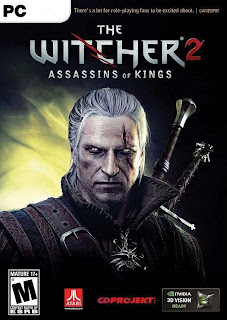With the exception of Steam and a few other determined developers, gaming on the PC is in a rapid decline. Piracy and the allure of greater profit on consoles have stymied the progression of gaming on a once-thriving platform. However, with the release of The Witcher 2: Assassins of Kings, Polish developer CD Projekt Red Studio is attempting to prove that sticking with the PC’s hardcore roots while simultaneously pushing the platform forward graphically will be enough to bring console gamers back to the mouse and keyboard.
The Witcher 2 is literally the Frankenstein of gaming. There are so many modern and old-school gaming tropes packed in that you’ll feel like you’re playing Baldur’s Gate one minute and Assassin’s Creed the next. This is the beauty and the curse of The Witcher. While many of the game’s elements will feel familiar, most of them have already been done better. Combat is clumsy, with the protagonist, Geralt taking far too long to implement attacks and even simple movement, at times. Button inputs sometimes won’t even register, and enemy targeting is a huge hassle. All these problems are amplified even further by the game’s group combat. When surrounded by a swarm of enemies, often you’re only chance at victory will be to cheese the system by getting foes stuck on the game’s environment and going in for a few quick blows.
A annoying as combat can be, however, The Witcher 2’s biggest flaw is the tutorial system, or to be more precise, the lack of one. True, the game teaches you all the basics of combat and map markers of objectives help, but seemingly obvious things like what spells do or how to mix potions aren’t covered. Whether this was bad development or because The Witcher 2 is callback to hardcore PC games is unclear, though the latter seems more likely. However, getting lost for hours at a time and dying constantly because you couldn’t tell that Yrden was the sign (i.e. spell) you needed to cast in order to stop a giant tentacle from smashing you are unforgivable, whatever the reason.
One thing that is obvious about The Witcher 2 is how impressive it is, graphically. It is among the games that truly push the limits of gaming PCs, looking gorgeous even on medium and low. Minute details like the texture of skin and light shining through trees are captured perfectly.
The Witcher 2 makes no concessions about its content; this game takes full advantage of its M rating. Blood flows like water and women ain’t shy in the world of The Witcher. Right of the bat, Geralt’s little lady, Triss is on full display and not soon after that, you’re cutting up badies left and right in a chaotic siege. There’s not a whole lot of romanticizing when it comes to the game’s fiction. Towns like Flotsam are filled with fat slobs, prostitutes and corrupt guards, and the way characters talk, you’d think everyone in the game was a sailor. If you’re looking for shinning knights and blonde damsels in distress, this isn’t the game for you.
While the unapologetic adultness of The Witcher 2 is refreshing and the major characters are decent enough, $50 is just too high a price for such a niche game. There are just too many problems with the gameplay and interface that will put off the average gamer. However, if you’re a hardcore gamer with a powerhouse rig and a lot of free time this summer, and you’re willing to stomach the atrocious combat, The Witcher 2 is right up your alley.











